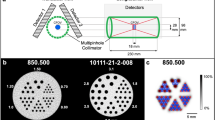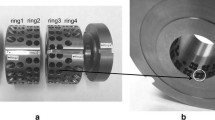Abstract
Purpose
Our goal was to evaluate a multi-pinhole (MPH) collimator which allows changing configurations for mouse imaging and rat imaging.
Procedures
The collimator length can be adjusted from 5 cm for rat imaging to a maximum of 8 cm for mouse imaging. Projections of mouse- and rat-size phantoms were simulated with collimator length of 8 cm, and the rat-size phantom was additionally simulated with collimator length of 5 cm. Bias and noise were assessed in the reconstructed images. Three physical phantoms were used to evaluate the axial sampling and resolutions for one-, four-, and five-pinhole single photon emission computed tomography (SPECT). Images of three different-sized rodents were also acquired.
Results
Simulations showed that for rat imaging, shorter collimator length provided an improved bias-noise trade-off compared to that of longer collimator length. Axial distortions were significantly reduced for MPH compared to single pinhole imaging. The smallest rods visible for mouse imaging and rat imaging were 1 and 1.6 mm, respectively, and their corresponding absolute sensitivities were 3.47% and 2.02% at the center field-of-view for 5-pinhole imaging. The count ratios were 1:3.78:4.42, respectively, for one-, four-, and five-pinhole for same acquisition time. Good image quality was observed in real animal studies.
Conclusions
This collimator allows flexible single pinhole and MPH SPECT imaging for rodents, achieving high resolution and detection efficiency with minimal image artifacts.









Similar content being viewed by others
References
Massoud TF, Gambhir SS (2003) Molecular imaging in living subjects: seeing fundamental biological processes in a new light. Genes Dev 17:545–580
Weissleder R, Mahmood U (2001) Molecular imaging. Radiology 219:316–333
Beekman FJ, van der Have F, Vastenhouw B, van der Linden AJA, van Rijk PP, Burbach JPH, Smidt MP (2005) U-SPECT-I: a novel system for submillimeter-resolution tomography with radiolabeled molecules in mice. J Nucl Med 46:1194–1200
Kim H, Furenlid LR, Crawford MJ, Wilson DW, Barber HB, Peterson TE, Hunter WCJ, Liu ZL, Woolfenden JM, Barrett HH (2006) SemiSPECT: a small-animal single-photon emission computed tomography (SPECT) imager based on eight cadmium zinc telluride (CZT) detector arrays. Med Phys 33:465–474
Lackas C, Schramm NU, Hoppin JW, Engeland U, Wirrwar A, Halling H (2005) T-SPECT: a novel imaging technique for small animal research. IEEE Trans Nucl Sci 52:181–187
Metzler SD, Jaszczak RJ, Patil NH, Vemulapalli S, Akabani G, Chin BB (2005) Molecular imaging of small animals with a triple-head SPECT system using pinhole collimation. IEEE Trans Med Imaging 24:853–862
van der Have F, Vastenhouw B, Ramakers RM, Branderhorst W, Krah JO, Ji C, Staelens SG, Beekman FJ (2009) U-SPECT-II: an ultra-high-resolution device for molecular small-animal imaging. J Nucl Med 50:599–605
Beekman F, van der Have F (2007) The pinhole: gateway to ultra-high-resolution three-dimensional radionuclide imaging. Eur J Nucl Med Mol Imaging 34:151–161
Jaszczak RJ, Li JY, Wang HL, Zalutsky MR, Coleman RE (1994) Pinhole collimation for ultra-high-resolution, small-field-of-view spect. Phys Med Biol 39:425–437
Schramm NU, Ebel G, Engeland U, Schurrat T, Behe M, Behr TM (2003) High-resolution SPECT using multipinhole collimation. IEEE Trans Nucl Sci 50:315–320
Strand SE, Ivanovic M, Erlandsson K, Franceschi D, Button T, Sjogren K, Weber DA (1994) Small animal imaging with pinhole single-photon emission computed-tomography. Cancer 73:981–984
Bal G, Zeng GL, Lewitt RM, Cao Z, Acton PD (2004) Study of different pinhole configurations for small animal tumor imaging. IEEE Nucl Sci Symp Conf Rec 1–7:3133–3137
Cao ZX, Bal G, Accorsi R, Acton PD (2005) Optimal number of pinholes in multi-pinhole SPECT for mouse brain imaging—a simulation study. Phys Med Biol 50:4609–4624
Nuyts J, Vunckx K, Defrise M, Vanhove C (2009) Small animal imaging with multi-pinhole SPECT. Methods 48:83–91
Rentmeester MCM, van der Have F, Beekman FJ (2007) Optimizing multi-pinhole SPECT geometries using an analytical model. Phys Med Biol 52:2567–2581
Beekman FJ, Vastenhouw B (2004) Design and simulation of a high-resolution stationary SPECT system for small animals. Phys Med Biol 49:4579–4592
Mok GS, Wang Y, Tsui BM (2009) Quantification of the multiplexing effects in multi-pinhole small animal SPECT—a simulation study. IEEE Trans Nucl Sci 56:2636–2643
Pan MH, Huang SC, Liao YP, Schaue D, Wang CC, Stout DB, Barrio JR, McBride WH (2008) FLT-PET imaging of radiation responses in murine tumors. Mol Imaging Biol 10:325–334
Pissarek MB, Oros-Peusquens AM, Schramm NU (2008) Challenge by the murine brain: multi-pinhole SPECT of 123I-labelled pharmaceuticals. J Neurosci Methods 168:282–292
Al-Shafei AIM, Wise RG, Gresham GA, Bronns G, Carpenter TA, Hall LD, Huang CLH (2002) Non-invasive magnetic resonance imaging assessment of myocardial changes and the effects of angiotensin-converting enzyme inhibition in diabetic rats. J Physiol Lond 538:541–553
Hastings DL, Reader AJ, Julyan PJ, Zweit J, Jeavons AP, Jones T (2007) Performance characteristics of a small animal PET camera for molecular imaging. Nucl Instrum Methods Phys Res Sect A 573:80–83
Wang Y, Mok GS, Tsui BM (2005) Derivation and implementation of a simple method for geometric calibration in multi-pinhole SPECT. In IEEE Nuclear Science Symposium and Medical Imaging Conference, Puerto Rico
Wang YC, Tsui BMW (2007) Pinhole SPECT with different data acquisition geometries: usefulness of unified projection operators in homogeneous coordinates. IEEE Trans Med Imaging 26:298–308
Mok GS, Tsui BM, Wang Y, Du Y, Segars WP, Frey EC (2005) Effects of pinhole pattern and multiplexing in multi-pinhole small animal SPECT. In 52nd Annual Meeting of the Society of Nuclear Medicine, Toronto, Canada
Vunckx K, Suetens P, Nuyts J (2008) Effect of overlapping projections on reconstruction image quality in multipinhole SPECT. IEEE Trans Med Imaging 27:972–983
Segars WP, Tsui BMW, Frey EC, Johnson GA, Berr SS (2004) Development of a 4-D digital mouse phantom for molecular imaging research. Mol Imaging Biol 6:149–159
Gabrielson KL, Mok GS, Nimmagadda S, Bedja D, Pin S, Tsao A, Wang Y, Sooryakumar D, Yu SJ, Pomper MG, Tsui BM (2008) Detection of dose response in chronic doxorubicin-mediated cell death with cardiac technetium 99 m annexin V single-photon emission computed tomography. Mol Imaging 7:132–138
Barrett HH, Furenlid LR, Freed M, Hesterman JY, Kupinski MA, Clarkson E, Whitaker MK (2008) Adaptive SPECT. IEEE Trans Med Imaging 27:775–788
Freed M, Kupinski MA, Furenlid LR, Wilson DW, Barrett HH (2008) A prototype instrument for single pinhole small animal adaptive SPECT imaging. Med Phys 35:1912–1925
Hesterman JY, Kupinski MA, Furenlid LR, Wilson DW, Barrett HH (2007) The multi-module, multi-resolution system (M3R): a novel small-animal SPECT system. Med Phys 34:987–993
Difilippo FP (2008) Design and performance of a multi-pinhole collimation device for small animal imaging with clinical SPECT and SPECT-CT scanners. Phys Med Biol 53:4185–4201
Defrise M, Gullberg GT (2006) Image reconstruction. Phys Med Biol 51:R139–R154
Acknowledgments
The authors would like to thank Dr. Kathleen Gabrielson from the Department of Molecular and Comparative Pathobiology at the Johns Hopkins Medical Institutions for providing the doxorubicin rat model, Mr. Gilbert Green and Mr. James Fox from the Small Animal Imaging Resource Program at the Johns Hopkins Medical Institutions for assisting the experimental preparations. This work was supported in parts by NIH Grants EB1558 and CA92871.
Conflict of interest
The authors declare that Dr. Benjamin M. W. Tsui is the co-licensor of software package and the recipient of research contract to Gamma Medica, Inc. Dr. Yuchuan Wang is the co-licensor of software package to Gamma Medica, Inc.
Author information
Authors and Affiliations
Corresponding author
Rights and permissions
About this article
Cite this article
Mok, G.S.P., Yu, J., Du, Y. et al. Evaluation of a Multi-pinhole Collimator for Imaging Small Animals with Different Sizes. Mol Imaging Biol 14, 60–69 (2012). https://doi.org/10.1007/s11307-011-0472-8
Published:
Issue Date:
DOI: https://doi.org/10.1007/s11307-011-0472-8




